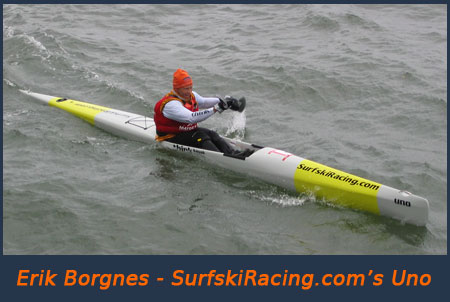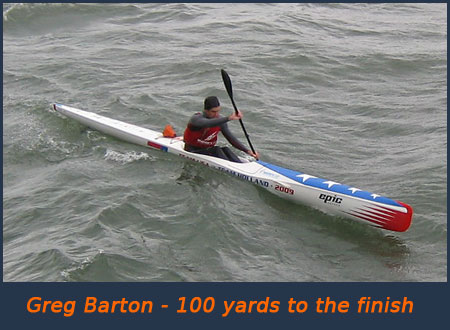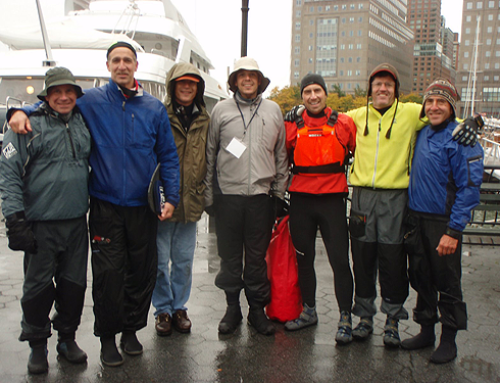The pre-race evening started innocently enough; I had the pleasure of staying with the exhaustingly-inquisitive Joe Glickman (the Glicker), old man Greg Barton, drop-waist jeaned and jovial Sean Rice, and the surly-appearing, crossword puzzle manic Bevan Manson. Our dinner conversation began with the predictable immature banter about our waitress’s finer qualities and how good were the surly one’s chances of getting her phone number, and ended with the question of “what if you were a conjoined twin with Oscar [Chalupsky].” “YOU USELESS F—-ING BASTARD!” 24 / 7 . . . forever. While funny at first, the gravity of that predicament brought us all back down to thoughts of the cold, the rain, and the next day’s race.

Race morning. It’s cold, windy, raining, and we’re downtown NYC. No beaches. Just concrete and buildings and boat traffic. The forecast nor’easter had timed itself perfectly and was to peak while we were supposed to be on the water. The temperature was 45 F (7 C), winds were sustained at 25 mph (40 kph), gusting to 40 mph (64 kph). The upbeat news was that the Hudson river was registering a 61 degrees F (16 C), the water on the latter part of the course was 55 F (12 C), and the wind was so strong that the rain drops were literally vaporizing before they hit the ground. Such was how the day was breaking. In contrast, two years ago, I remember facing NW at dawn, soaking in the warmth of the sun’s reflection on the glass facade of a skyscraper while enjoying my free coffee and bagel with cream cheese.

So, long story short, race director Ray Fusco had been conversing with several of us during the previous day and a set of alternative race plans had been drawn up in the event of varying degrees of rough weather. The decision on race morning was to go with the most extreme of the plans, i.e. only “red vested” elite level paddlers would be racing today. I think for some, it was disappointing, while for others, it was a relief. The Glicker couldn’t lend out his ski fast enough to another racer who happened to be ski-less. Only about 30 paddlers would be allowed to start. Of those, about 10 either turned back early, mid-course, or didn’t even bother to change into their race gear.
The water at the put-in in North Cove Marina was empty of paddlers until the last possible moment as no one was anxious to get out from under the shelters. The water there was deceptively calm. Finally, and on time, the first wave started, composed of double kayaks and double skis. I believe that half of them eventually turned back for the shelter of North Cove. The elite surfski start had about 20 boats, all of whom had been selected as being capable through known experience, or through internet searches, done the day beforehand, of their international race results. Unfortunately for one of them, his boat was a modified ICF K1, a Nelo Sea Vanquish, (‘sea sandwich?’ came to mind given the days conditions). That gentleman was kindly tapped on the shoulder and escorted back off the dock. Safety personnel on the launch dock made sure that every racer had either a waterproof cell phone or a vhf radio – and they were serious about that. Five minutes before the start, I watched a safety officer fasten a vhf radio to the pfd of a Dutch paddler while he was sitting in his ski. In broken English, he replied, “Thank you!. . . how do I use this? . . . do I just push one of these buttons and say mayday, mayday?” If you had any chinks in your self-confidence given the day’s conditions, they would have been hard to contain.
The start wasn’t classically frantic for obvious reasons. We all had to round a buoy located about 40 m offshore and upstream and then we headed straight north up the Hudson, with the incoming tide pushing us north and the tempest beating us back south. I didn’t have my gps with me, but my guess is that for that first 20 km up the Hudson, I was traveling at 6 mph, with about 3 mph of that my boatspeed relative to the water, and the other 3 mph the speed of the current. And it was brutal. Wind waves were on average 3 -4 ft (1+ m) but easily 6 ft (2 m) quite frequently. The fastest route was way out in the middle as would be predicted due to the laminar flow. But, in the middle, the water was entirely whitecaps. Whitecapped whitecaps. Even the troughs were flattened and whitecapped out. Clear vision was a continual problem because of the pounding from all the spray and wind. When you’d take a long blink to clear your eyeballs, you’d open them seeing an entirely different set of waves before you.
For the first hour, I was rotating in a loose group with Ed Joy, Wes Hammer, Rami Zur and a Dutch paddler. We obviously weren’t riding wake. We were simply within 911-whistle distance of one another. Each of us knew that the sanctuary was just past the George Washington (GW) bridge, where we would be turning into the Harlem river. The problem was that the bridge just never seemed to get any closer. In last year’s cancelled race, I think that I reached the GW bridge, 10 miles from the start, in about 1 hr 15 min or so. In ’09 it would take about 1 hr 45 min. As we progressed up the Hudson, I made the decision to paddle a river-right course where the average wave size was smaller, knowing that the current speed would be lesser, too. My meandering line was along the line of floating debris – logs, sticks, garbage – that separated the faster from the slower flow. In there it was less hectic on average, but the shear between the faster and slower flow made for some interesting standing waves. Two times, I threw my legs out and braced with the paddle in a hail Mary maneuver as I encountered extra steep six foot (2 m) waves that had foaming white tops. I rarely ever throw my legs out but these two spots looked really ugly and my Uno looked really small underneath me. After a few big brace moments, I continued even more towards the right bank, and at one point, I paddled directly over a one-meter-diameter steel yacht mooring buoy that was being forced about 8 inches (20 cm) underwater by the strong inflowing current. While I stayed right, I watched the others in the center channel move steadily ahead. The GW bridge finally came and went and it just didn’t get any easier.
Two and one half more miles (4 km) into the storm until the turnoff into the Harlem. I watched the three paddlers ahead of me head river-right immediately after the GW bridge. Ed Joy, who was one of them later told me that he was getting a bit frazzled by being out in the middle for so long. I had earlier watched EMS and police vehicles with lights a-blazing driving up along the shore to my right, stopping at the foot of the GW bridge, and I had also heard one of the Coast Guard or Police boat’s sirens sounding to my left, out in the middle of the river. I really couldn’t look around to see what was going on, and even if I could have, I wouldn’t have been able to see any swimmers or bobbing white skis, or been of any help to anyone anyhow.
The turn into the Harlem was a relief, to say the least, even though we had to contend with beam waves during the turn-in. Now, after 2 hours of paddling, I could finally grab my drinking tube. Unfortunately, I mis-mixed it and it tasted pretty much like the mouthful of brackish Hudson river that I had rammed down my throat by a breaking wave an hour earlier. (Mental note to self – put more effort into mixing the drink next time.) Straight away, I saw two Dutch paddlers who had slowed for a bit. Apparently, one of them was trying to coax the other into continuing on as he was a bit scared by the conditions in the Hudson. Rounding a corner in the distance I could see one more paddler. I was cursing myself for not having a gps with me now because the Harlem current was subtle and it was difficult to sense whether it was going with me or against me. The Dutch guys were out in the middle, I was on the right bank, and I was reeling them in really quickly, so therefore, we were going into about 1 mph (1.6 kph) current. After a mile or so, with the gusty tailwind, waves started to form and surfing these runners in the middle of the river turned out to be quite fast and fun. Probably due to the particular combination of current, wind, the runners were going at about 8-10 mph judging by how quickly the bank was passing by. The route through the Harlem was about 7.5 miles (12 km), and I had great surfing for about half of it. At some points, the river current rotates or switches unpredictably, so this whole stretch was quite a puzzle to figure out. The other problem was that, going into some turns, it was difficult to predict if the river ahead was going to go right or left, and more than once, my line was outside to outside as opposed to the faster inside to inside turn line.
The Harlem dumps into Hell Gate. This is where I had a trick up my sleeve. For the month beforehand, the Glicker and I had been debating over the best path through the Gate. Specifically, do we go left or right of Mill Rock which is located smack in the center of the channel. The default line is to go right. By the time I got to this point, I was so far back, and feeling more than a bit wobbly, that if the east route was slower it didn’t really much matter. My head was still clear and my energy level was fine. Left (east) of Mill Rock turned out to be the faster line, I think. Only, I kind of messed it up. I went left of Mill rock but hugged in too close into the rock. This meant that the current coming in from Long Island Sound was pushing me in towards the rock and then back west after I had passed the rock. Had I gone more east initially, I could have gotten out into much better flow. Reid Hyle, the top US marathon K1 paddler, took that better east line and confirmed that he made up hundreds of meters on the guy ahead of him who went right of Mill Rock. So, there I was, now past Mill Rock, being pushed west into the “joining” of the two current flows, and it was, as you might imagine, not so inviting. I couldn’t really find an escape path, so I more or less went into “keep the ski upright” mode, and hoped for the best. Then I swam. I got hit by a conveyor belt of water from the left, maybe when I was paddling on the right, and over I went. The water was cold, about 55 F (12 C). I had on a leg leash, and my ski and I were still traveling towards the East river at about 5 mph (8 km) in the current waves. My side saddle remount was successful and accompanied by thoughts of “don’t screw this one up”
I entered the East River with virtually no boat balance muscle strength left. Turns out the East river was pretty flat with maybe 1 foot (30 cm) waves throughout. Some larger 2 foot (60 cm) waves were stacking up underneath the 59th street bridge where there was literally a rapids set up by the differential between the Long Island Sound to the north, and the New York Harbor to the south. That was where the faster water was. I, on the other hand, was looking for the flatter water and ultimately for the finish line or any way off of the water. Had there been an accessible dock between there and the finish, I might have headed for it, but the walls of the East river are all concrete and flush. It was about that time that I noticed a paddler a few hundred meters ahead and the flashing blue light police boat escorting him. For some reason I looked around and found that I ,too, had a police boat with me. There is no greater boost in confidence that seeing that.
The flat East river water was really difficult for me in the condition that I was in as the swirls were continually tripping my bow to the left or to the right. For the next few miles, I limped along with wide and low half strokes, now fighting between staying in the flatter slower water and stealing some current when I could, in hopes of catching the paddler ahead of me. As I got down past the Brooklyn Bridge and towards the Battery, I looked out on the statue of Liberty in the distance, and got a fleeting moment of pride and a boost in self-confidence for having nearly completed this course on this day. However, I couldn’t help noticing that the water between me and Lady Liberty, where the East River joins the Hudson, looked absolutely gnarly. I pulled off into a respite of flat water in the lee of a big ferry dock, and threw my legs out to mentally prepare for the final 2 miles – and to verify that there was no accessible dock in the area. Fifty meters ahead of me, a 3 story tall Staten Island Ferry was preparing to leave its berth, so I waited for a few minutes. At that point, I had not one, not two, but three escort motor boats with me. Either I was the last man standing and on my way to win the ’09 Mayor’s Cup, or . . . disappointingly the last paddler in, ouch. In reality, I think it was just a precautionary measure because of the busy ferry terminals. Either way, though, it became obvious that the easiest way off the water and out of the race was to swim and climb up onto one of those motorboats because there was no easy looking exit on the shore. I hollered over to the driver of one of the escort boats and asked what it was like around the Battery to the finish. He motored over and replied “ahhh, it’s a bit bumpy around the corner but not too bad. You’ll be fine. I’ll follow ya.” That made me smile really big as now I realized that I very likely wouldn’t die and that there were guys ready to pull my sorry arse out of the water in the event that I went over.
So around I went. Around the fishing lines and around the corner into the now outgoing current just pouring down the Hudson. I saw Wes Hammer from Canada out about 20 m off the wall and going nowhere fast – he might have even been going backwards. I stayed about 2 m off the wall in meaty and wild 2-3 ft (1 m) rebound slop getting battered left and right. Pedestrians on top of the eight foot high Battery wall were walking faster than I was able to paddle. Although I could see the finishing marina entrance about 700 m further, it was almost humorous to be thinking that here I am, there it is, and I’m not sure if I am going to make it there. I’ll bet that it took 15 minutes to do that last km.
Finally, I made it to the marina, to the dock, and not less than six people helped me out of the ski and onto the dock. I remember being asked “how was it?” “It was horrible”, was my reply. “Just horrible”. Someone chuckled and said that is what everyone before me had said, too. Horrible, hideous, horrendous times 2.
Now, 24 hours later, my eyes are pink and my eyelids are swollen half shut from the beating they took heading up the Hudson. It was one of those races where it just sucked being out there, but it would have sucked worse to have quit or to have not started at all. And, as we all know, we racers are kind of thick headed and our memory is short lived for try-ing events. So, now I’m already starting to think about the 2010 Mayor’s Cup – staying out in the faster water in the Hudson, remembering my gps, and of not screwing up the path around Mill Rock . ~ Erik


Leave A Comment
You must be logged in to post a comment.